Meditations on distinguishing "the real" from "the fake"
And that’s what we’re looking for when we look at art, no? Something of value, deeper and more meaningful than a name or a number, which can’t be gotten out of a test tube or lab report, which, emotionally speaking, requires an effort on our part. It demands that we look for ourselves.
And then you never know what you might find. A “Virgin and Child With an Angel,” an early work by Francesco Francia, the Bolognese master and contemporary of Raphael, for years was said by the gallery to exemplify the painter’s training as a goldsmith. Its refinement was admired. Then an identical picture turned up. Gallery conservators examined their version and found that the tiny aging cracks on the surface had actually been painted, faked. Further studies revealed the use of latter-day pigments like chrome yellow, and an underdrawing that seemed more 19th century than Renaissance.
The work was a forgery. Science proved it. And so there it hangs in the show, on a wall of shame, surrounded like a mug shot by the evidence of its true crime.
But look, never mind what the label says, and you may notice something else about the picture, too, some other truth.
It’s beautiful.

Labels: Portland





0 Comments:
Post a Comment
<< Home